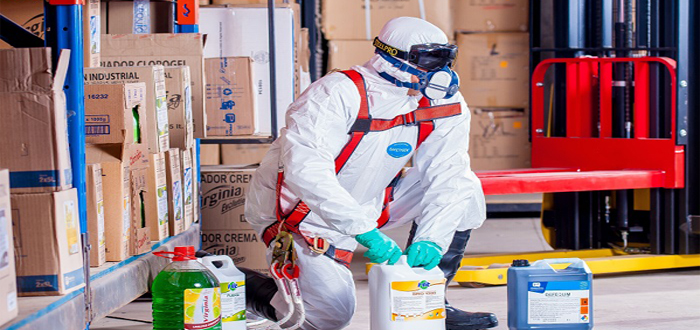-
ROSSLARE EUROPORT TARGETS HEALTH & SAFETY WITH CAMERA TELEMATICS PARTNERSHIP - 2 days ago
-
Landmark Study Reveals Wearable Robotics Significantly Boost Safety and Efficiency in Industrial Environments - July 24, 2024
-
Visku Tackle The Retail Seasonality Challenge One Pallet At A Time - July 22, 2024
-
KAMMAC AND BERGEN LOGISTICS STRENGTHEN FASHION & LIFESTYLE SERVICES IN THE UK - July 19, 2024
-
TENTBOX EXTENDS PARTNERSHIP WITH ARROWXL TO SUPPORT INCREASING DEMAND - July 17, 2024
-
The Perfume Shop improves customer journeys while driving profitability in partnership with Scurri - July 17, 2024
-
ZEROMISSION SECURES £2.3M ($3M) INVESTMENT TO ACCELERATE ELECTRIC FLEETS - July 16, 2024
-
BCMPA CELEBRATES SUCCESS OF 2024 CONFERENCE - July 15, 2024
-
Best of the Best: Jungheinrich Celebrates Triple International Award Win - July 12, 2024
-
GOPLASTICPALLETS.COM CALLS ON NEW CHANCELLOR RACHEL REEVES TO CONSIDER PLASTIC PACKAGING TAX REFORM - July 10, 2024
3 steps to safe chemical warehousing.
Lauren O’Connor works for Zoro, a retailer of industrial tools, cleaning products and protective clothing and equipment. She shares the essential safety procedures that all warehouses who handle potentially hazardous chemicals should follow.
All chemical agents — from everyday cleaning products to heavy-duty industrial supplies — can become dangerous when handled or stored improperly. As an employer, it is your legal obligation to take measures that will help protect your employees and reduce the risk of an accident involving chemicals. That’s why the law provides a framework for storing packaged hazardous substances, as outlined in the Control of Substances Hazardous to Health Regulations (2002).
So, if you need to store potentially dangerous chemicals in your warehouse, then it’s crucial that you abide by the rule and regulations and do everything possible to safeguard the health of your staff. These are the three essential steps you need to take to keep your chemical products secure and your employees safe.
1. Ensure workers have the correct protection during handling
Chemical products can cause burns, produce harmful vapours and fumes, and cause long lasting damage to eyesight, so you need to provide your staff with the proper PPE (personal protective equipment) to keep them safe on the job. Each chemical will have different safety considerations, so you’ll need to tailor the equipment you use to the chemical being handled.
For instance, corrosive chemical agents will damage the skin and eyes, so protective clothing, chemically resistant gloves and eye protection should always be worn when handling them. When dealing with products which produce vaporous gases, your staff should be fitted with respiratory masks and airtight googles. If you’re unsure, then check the manufacturer’s instructions to see exactly what PPE you’ll need.
2. Carry out a risk assessment
You’ll need to carry out a risk assessment for each chemical in your inventory. This assessment will need to thoroughly consider the potential hazards each of your chemicals present, and think of how you can effectively minimise the risks. Don’t forget about waste chemicals and by-products, as you also will need to carry out a risk assessment for the safe storage and disposal of these, too.
You will need to identify the intrinsic properties of each chemical, including whether they are flammable, corrosive, irritating or toxic. You’ll also need to know whether they have any unique storage requirements: for instance, will they need to be stored in specific type of container, or will they require ventilated or temperature controlled storage? How will you contain a chemical spillage, or evacuate safely in the event of a gas leak?
Once you have completed your risk assessment, you can begin training your staff so they understand both the potential risks and what they need to do to prevent them from happening.
3. Store and segregate chemicals safely
When it comes to storing chemicals, one of the most important safety concerns is keeping them safely segregated. Storing hazardous chemicals in unsuitable equipment and containers increases the chances of packaging fault, which can lead to chemicals becoming accidentally mixed. This could potentially cause inadvertent reactions between different chemical materials, which could lead to spillages, fires or even explosions.
To minimise the risk of this happening, chemicals should be stored in the original manufacturers’ containers. These containers will be up to the job of containing the chemical, and they’ll also list the necessary safety and handling information for easy access. Chemical products should be stored alongside materials with similar chemical properties, as these will prove less volatile in the event of cross-contamination. Extremely flammable materials should be kept separately — preferably behind fire-resistant doors for added protection.
When it comes to storing hazardous chemical materials, nothing is more important than the safety of your staff. Follow these three essential steps, and you should be able to minimise the risk of accident and injury in your workplace.

































